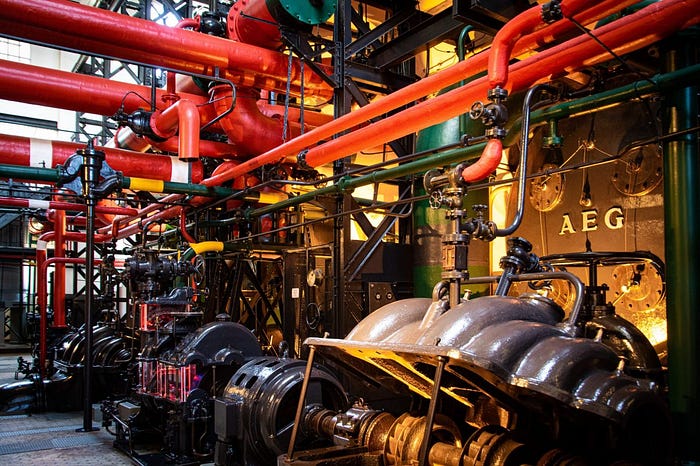We Can Replace Dirty Energy Furnaces and Boilers Like This
 The Urban Monk
The Urban Monk
Heating and cooling homes, in this economy?
Unfortunately, the longer climate change progresses, the more necessary it will be. It’s a huge problem for reducing emissions — not as big as decarbonizing transportation, though — as 10% of our national emissions come from regulating buildings.
The U.S. produced 4.57 million metric tons of carbon dioxide emissions in 2020. 10% of that is a huge amount — 457,000 metric tons.
In order to get where we want to go, we have to take stock of where we are right now. Otherwise, any static we make at lawmakers and government programs aiming to help individual homes transition away from oil-based heating and cooling systems will fail to impact us.
As of 2017, the most common way to heat a home was with a central furnace. About 40% of homes in the U.S. were using a natural gas central furnace, out of the 48% total using a heat system supplied buy natural gas.
Only 37% of homes are all electric. (Although electricity also runs on fossil fuels, that power — 4.01 trillion killowatthours in 2020 — is generated by steam turbines of which about 60% run on FFs — coal, natural gas, petroleum, etc. So last year, 2.406 trillion kWh of electricity came from dirty fuel sources.)
In most regions in the States, these are your most common options to heat or cool your home…
Furnace
How it works: Furnaces typically ignite natural gas or propane in the burner. That fire warms a heat exchanger, which transfers its heat to the incoming air. The blower motor then forces that air into the ductwork of the home and distributes it throughout. Cold air gets sucked in through return ducts, which the furnace gets to work heating up again.
Most furnaces in the U.S. are powered by fossil fuels, although they can be electric.
Boiler
How it works: Through a gas or oil-fired burner, a boiler furnace heats water and then distributes the steam — through pipes, radiators, or convectors — throughout the home, where it hisses through radiators and heats individual rooms. The steam condenses in the pipes, returns the cool water to the furnace, and the process begins again.
As with furnaces, electric boilers exists, but fossil-fuel-powered systems are much more common.
Air Source Heat Pump
How it works: Rather than creating its own heat, heat pumps bring in air from outside and heat it Powered by electricity, the heat pump heats the air it takes in with compressed coolant, and then forces that air through the home. They can also cool, by removing hot air from inside the home and sending it out.
Electric Heating
How it works: Incoming electric energy is converted to heat, which is technically considered 100% energy efficient… Except that electricity is produced mostly through fossil fuels. In fact, only about 30% of the fossil fuels’ energy becomes electricity, making this rather an expensive option. Electric heating can come in furnace, baseboard, or standalone form. In furnaces, large fans move air over electric elements which heat that air. In baseboards, the electric elements are inside the encased pipes.
What Should We Be Using?
It’s clear that no matter what we do — besides living in a temperate zone where no climate manipulation is necessary — we’re using fossil fuels.
But transitioning away from dirty energy isn’t about perfection. It’s about mitigation. And remember, as consumers, that’s as much as we can reasonably expect of ourselves. After all, outside of lobbying, voting, and protesting, we can’t change what the electric grid runs on.
That said, the electric air source heat pump is easily your most energy-efficient option.
The tech is as old as 1856, and pumps were available for consumers in the U.S. by the middle of the 19th century.
And even though they run on electricity, they reduce your electricity usage by about 50%. Plus, just because they run on electricity now doesn’t mean they won’t be running on renewable energy shortly in the future…
Especially if the government invests sizeably in clean energy as they’re expected to. (In some places, huge advancements have already been made!)
Do They Pack the Power?
The common complaint about air source heat pumps has been that they’re not powerful enough to heat a home through, say, a Boston winter.
But years of advances and upgrades have dispelled that argument and proven that not only do they keep up… They save users tons of money over the six-month darkness.
Updating household heating and cooling systems to run on electricity is the next huge hurdle in reducing emissions. 20% of greenhouse gas emissions in the U.S. come from home residences — electrifying homes, even before the grid is made renewable, would slash those emissions enormously.
Just like replacing your cleaning products or using beeswax covers instead of plastic baggies, you don’t have to rip out your propane furnace right now.
When the time comes to replace your energy system — which might be now, we don’t know! — consider setting up your family to spend less, use less, and contribute less to the climate crisis.
If you enjoyed these thoughts and think we’ve got something in common, I have a feeling you’re going to love the streaming service I launched last year — whole.tv. It’s my answer to the dilemma of conscious consumption, where you’ll find ALL of my documentaries and series, as well as more from renowned thought leaders like Nick Polizzi, Dr. David Perlmutter, Dr. Tom O’Bryan, and more. Try it for two weeks — on me.


























![[LIVE] Engage2Earn: McEwen boost for Rob Mitchell](https://cdn.bulbapp.io/frontend/images/c798d46f-d3b8-4a66-bf48-7e1ef50b4338/1)






































